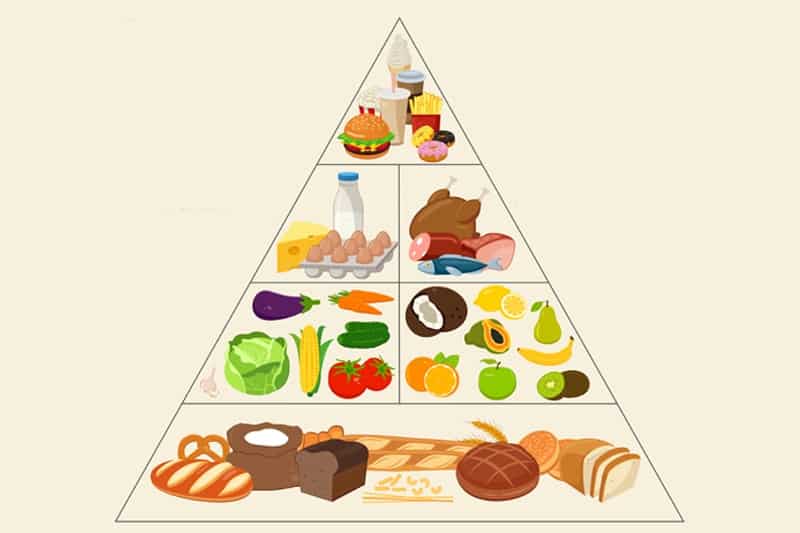What is the Diabetes Food Guide Pyramid
The Diabetes Food Guide Pyramid is a helpful, modified version of the USDA’s Food Guide Pyramid and updated MyPyramid model. It places certain foods in categories that might not seem logical—such as placing cheese in the Meat and Others group instead of the Milk group—as the guide considers carbohydrate content, protein, and fat content instead of traditional food classifications.
For example, vegetables that are high in starch, such as peas, corn, winter squash, sweet potatoes, potatoes, and beans, are placed in the Grains category at the bottom of the pyramid due to their similar carbohydrate content to grains. Portion sizes also vary between the USDA’s food guides and the Diabetes Food Guide Pyramid. For example, one serving of pasta or rice in the Diabetes Food Pyramid is 1/3 cup, though it is ½ cup in the USDA guide. A serving of fruit juice is ½ cup in the Diabetes Food Guide Pyramid, though it is 1/4 cup in the UDSA pyramid.
What is the food guide used for?
The Diabetes Food Guide Pyramid helps people living with diabetes make healthy food choices. Unlike traditional guides like the Canadian Food Guide or the Food Guide Pyramid, the Diabetes Food Pyramid focuses on helping people keep their blood glucose under control.
In addition to helping people manage their blood sugar, the Diabetic Food Guide Pyramid can help people manage their weight, blood pressure level, and cholesterol. It can also help reduce the risk of serious diabetes complications like heart attack or stroke.
How to use the Diabetic Food Guide Pyramid
The Diabetes Food Guide Pyramid separates foods into six different groups, with recommendations for minimum and maximum daily servings per category. The foods at the bottom of the pyramid require more servings than the ones at the top. At the base of the pyramid is the Breads, Grains, and Other Starches group, with Vegetables and Fruits as two separate categories in the tier above. Second from the top are the Milk and Meat, Meat Substitute, and Other Proteins categories, with Fats, Oils, and Sweets at the very top.
When following the recommended servings per group, the minimum to maximum number of calories consumed ranges from 1,600 to 1,800. A diabetic’s ideal foods and number of daily servings varies according to their individual caloric and nutritional needs, lifestyle, and diabetes goals.
Grains and Starches
The Bread, Grains, and Other Starches category contains foods that are made predominantly of carbohydrates. Foods in this category include bread, cereal, rice, pasta, dry beans, and starchy vegetables. People should eat between 6 and 11 servings from this category each day.
Vegetables
The Vegetables category contains foods that are naturally low in fat and high in vitamins, minerals, and fiber. They make a great low-calorie snack and should be included often in meals. Foods in this category include chicory, sorrel, Swiss chard, spinach, cabbage, broccoli, bok choy, Brussels sprouts, kale, carrots, cucumbers, lettuce, tomatoes, cauliflower, and lettuce. A serving is 1 cup raw or ½ cup cooked. People should eat between 3 and 5 servings per day.
Fruit
The Fruit category comprises foods that contain carbohydrates and are a great source of vitamins, minerals, and fiber. You will find cantaloupe, strawberries, blackberries, oranges, bananas, apples, pears, peaches, grapes, and apricots in this group. Serving sizes vary and the recommended intake is up to 4 servings from this category per day.
Milk
The Milk category consists of foods that contain a lot of calcium, protein, and other vitamins. Non-fat and low-fat dairy products are recommended as they do not contain saturated fat. A serving in the Milk category is 1 cup of non-fat or low-fat milk, or 1 cup of yogurt. People should eat up to 3 servings per day.
Meat and Meat Substitutes
The Meat Substitute and Other Proteins category consists of foods that are good sources of protein, vitamins and minerals. Foods in this group include meats like beef, turkey, and chicken as well as fish, eggs, tofu, dried beans, cottage cheese, cheese, and peanut butter. Lean meats, fish, and poultry are ideal, and portion sizes should be small. People should aim to eat between 4 and 6 ounces per day. Serving size varies by food.
Fats and sweets
Finally, the Fats, Oils, and Sweets category includes foods that contain a lot of sugar or fat. They do not contain as much nutrition as other the foods in other categories and should be reserved for special treats. Foods in this category include candy, cakes, crackers, potato chips, and fried foods. Serving sizes vary.
Doctor’s Recommendation
Dietary recommendations are a hotly contested topic among healthcare providers, as there are two general schools of thought. The first group adheres strictly to dietary guidelines, whereas the other group makes recommendations based on primary literature. Many guidelines based on flawed research need to be corrected. It is optimal to adhere to a nutritionally dense diet that is also as low in carbohydrates as possible. Ideally, it is a sustainable, lifelong diet that does not feel restrictive for the patient.



